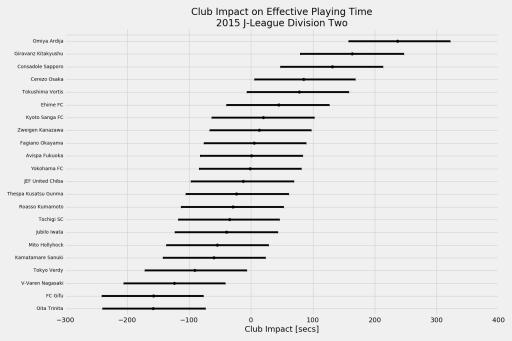Effective time in J-League 2015: Club impact in J2
Categories: Match Quality Metrics
Continuing from my previous post on club impacts on effective time in J-League Division 1 matches in 2015, I look at the same for clubs competing in the 2015 J2 season. The previous post contains background information and the modeling methodology, so I will present just the graph here.
Here’s some summary data on effective playing time in J2 matches:
- The mean effective playing time in 2015 J2 matches was 3133 seconds or 52 minutes 13 seconds. This amount represents a 137 second decrease over mean effective time in the 2014 season, and a four-minute drop from the 2013 J2 season.
- Standard deviation of effective playing time in J2 matches was 293.2 seconds, or 4 minutes 53.2 seconds, which is 37 seconds narrower than standard deviation in the 2014 J2 season.
- Match with highest amount of effective playing time: Consadole Sapporo vs Giravanz Kitakyushu (65 minutes 27 seconds, matchday 19)
- Match with smallest amount of effective playing time: FC Gifu vs V-Varen Nagasaki (36 minutes 28 seconds, matchday 10)
Below is a plot of club impacts on effective playing time in J2. Omiya Ardija, Giravanz Kitakyushu, and Consadole Sapporo have the greatest positive impacts on effective time, while Oita Trinita, FC Gifu, and V-Varen Nagasaki have the most negative impacts. Beyond those teams, the impact of the rest of the J2 sides on effective match time is a wash.
You can find the effective playing time data from the 2013 J-League season to the present in the jleague-effective-time folder of the Soccermetrics Project Data repository on GitHub. I’ve also included an iPython notebook of the Bayesian analysis so that you can work out the analysis for yourself.


